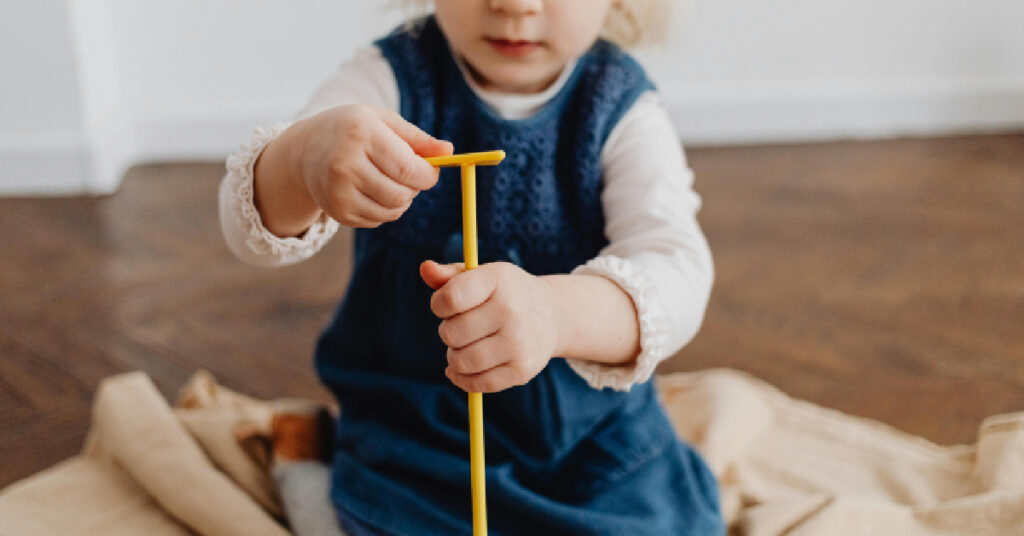
15 Best Toys for Building Independence — That Aren’t Boring or Overhyped
From magnetic tiles to dolls and pretend kitchens, these 15 toddler toys are actually worth the shelf space — and designed to encourage solo play
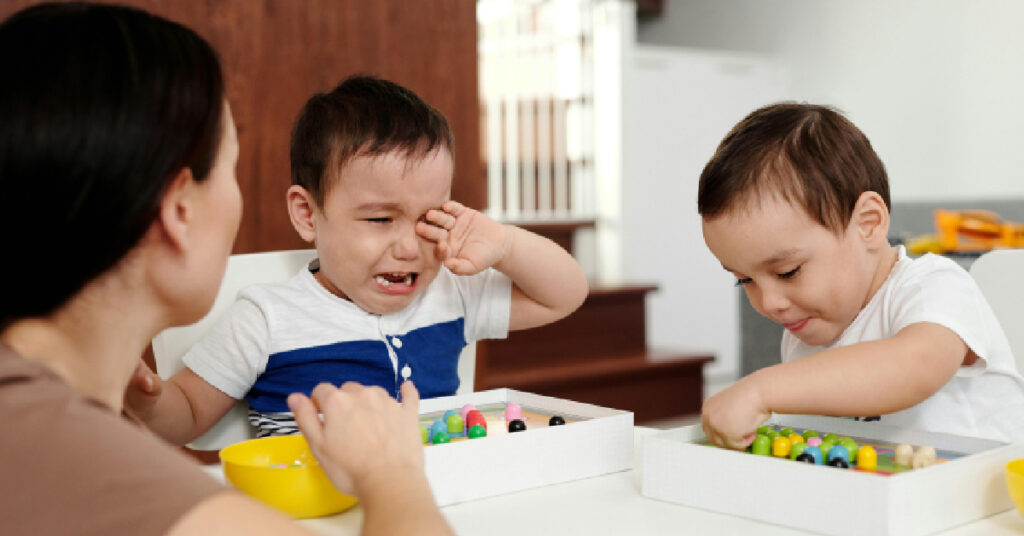
If you thought solo toddler play was hard, just wait until you’re trying to get two kids to play together — quietly, cooperatively, without you becoming a full-time referee. Welcome to the chaotic, beautiful, often-exhausting world of sibling independent play.
You set them up with toys. You step back, praying for five peaceful minutes. And then — the scream. The snatch. The “Mum! He won’t let me!” It’s like an Olympic event, and you didn’t train for it.
Here’s the truth: if your kids struggle with sibling independent play, it’s not because they’re “bad at playing” or destined to fight forever. It’s because playing together without constant adult input is a learned skill — and like all things toddlerhood, it takes time, patience, and a few strategic tricks to build.
This blog is your real-talk guide to sibling independent play: what it is, why it matters, and how to encourage it without losing your mind in the process. We’ll break down what actually worked in our house (after many failed attempts), what toys support it, and how to handle the inevitable chaos along the way.
So if you’re dreaming of a world where your kids can play together while you finish a coffee while it’s hot — you’re in the right place.
Let’s get real for a sec — sibling independent play sounds simple in theory: your kids playing either together or side-by-side without you stepping in every 14 seconds to separate arguments, find lost parts, or explain why LEGO heads aren’t for chewing.
But in reality? Sibling independent play is more like a chaotic blend of co-play, negotiation, turn-taking, sharing, and conflict resolution — all happening in real time, with toddlers who still think “mine” is a personality trait.
So what actually counts as sibling independent play?
It’s when siblings:
Play with shared materials without adult interference
Play in parallel but peacefully side-by-side
Solve little disagreements (or ignore each other productively)
Keep themselves engaged long enough for you to do something other than mediate
Because most toddlers and preschoolers:
Haven’t mastered emotional regulation yet
Are developmentally still learning turn-taking and perspective
Want the same toy at the exact same time even if it hasn’t been touched in days
Have different play styles, ages, and attention spans
Sibling independent play takes practice, setup, and (let’s be honest) a fair amount of patience. But once it clicks — even just for a few golden minutes at a time — it changes everything.
You get a breather. They build confidence. And the whole vibe at home feels a little less like a live-action Hunger Games.
Read More: Independent Play by Age: What’s Realistic at 1, 2, 3, 4, and 5?
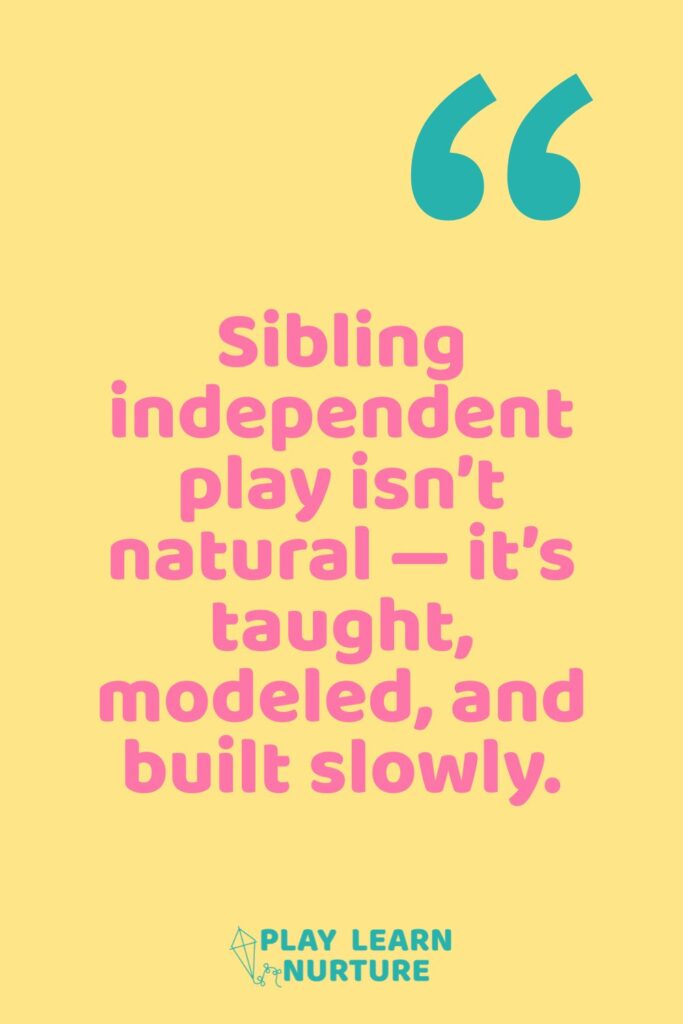
Let’s be honest: encouraging sibling independent play can feel like herding glitter-covered cats — loud, unpredictable, and somehow always messier than expected. So why bother?
Because underneath the chaos, sibling independent play is doing something magical. It’s not just about giving you five uninterrupted minutes (though that’s a bonus). It’s about teaching lifelong skills that toddlers and preschoolers desperately need — and can only learn through real-time, real-life practice.
Sibling independent play builds:
Emotional regulation: they learn to wait, negotiate, and recover from “that’s mine!”
Collaboration and creativity: shared toys become team projects (eventually)
Empathy: they begin to notice and respond to each other’s needs
Confidence: the more they manage play without you, the more capable they feel
And yes — it also encourages deeper focus, longer play sessions, and fewer screen-time requests. Not bad, right?
You get a break. Even if it’s short, it counts.
Less guilt. You’re not constantly choosing between one child and another.
More calm. Knowing your setup supports sibling independent play lets you breathe easier — and yell less.
Even when it doesn’t go smoothly (and it won’t, at first), every attempt at sibling independent play is a chance for your kids to grow. And a chance for you to step back and remember: you don’t have to entertain them all day. You’re here to guide — not perform.
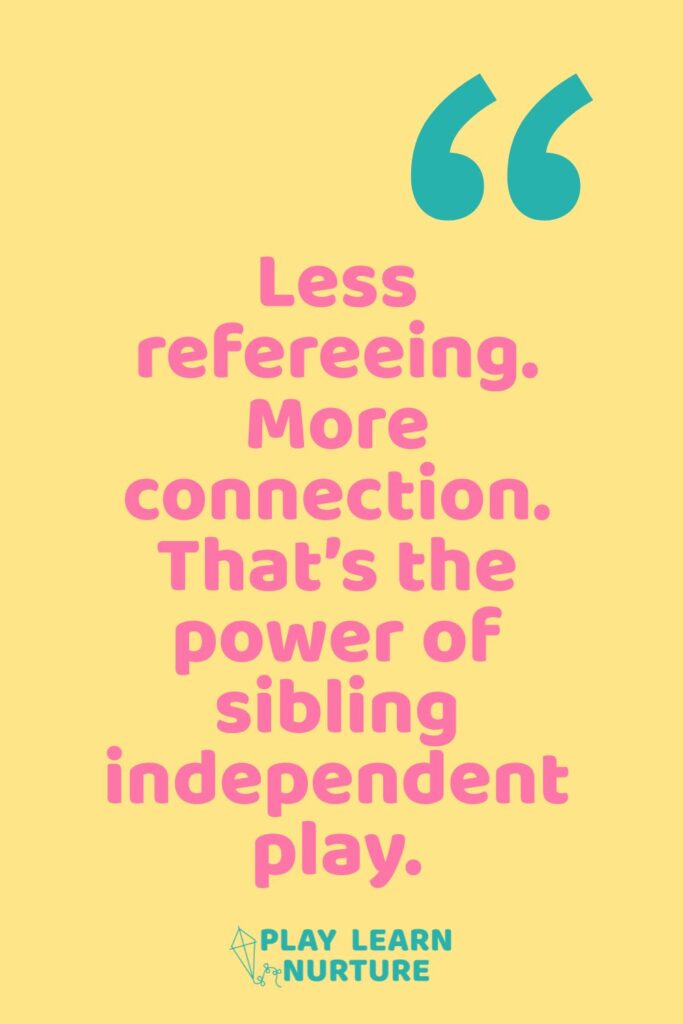
You’ve tried setting them up with toys, giving them space, maybe even bribing them with snacks — and still, sibling independent play feels like a distant dream. The good news? It can happen. These strategies actually made a difference in our house (after a lot of trial, error, and deep breathing in the pantry).
Each one supports sibling independent play in realistic, low-effort ways — no rainbow-labeled bins required.
Toys that don’t “do” the playing for them are perfect for sibling independent play. Think blocks, magnetic tiles, loose parts, and play silks — anything that can be built, torn down, and reimagined 10 different ways.
Why it works: There’s no one “right” way to use them, which means less competition, more cooperation.
Read More: Minimalist Toys Toddlers Actually Use: A Real Mum’s Guide to Open-Ended Play Essentials
Yes, they’re playing together — but they don’t have to be on top of each other. Use rugs, low shelves, or even painter’s tape to gently define separate areas for parallel play.
Sibling independent play often starts best when kids feel they have some space to themselves.
Read More: The Power of “Yes Spaces”: Safe Environments That Invite Play
If one sibling is more independent or older, let them start play solo for a few minutes. Then bring the second child in — chances are, they’ll follow the lead rather than compete.
This sets up sibling independent play as a collaborative opportunity, not a takeover.
Especially for toddlers, sibling independent play might just mean playing next to each other peacefully. That’s a win. Start there, and let shared play develop naturally over time.
Grab two spoons at snack time. Alternate who opens the fridge door. These everyday moments help build the emotional muscle needed for smoother sibling independent play later.
Instead of only stepping in during fights, try catching the good stuff. “I noticed you two were building side by side without grabbing. That was awesome!”
Positive reinforcement helps toddlers repeat the kind of behavior that supports sibling independent play.
They’re not going to go from screaming matches to cooperative tea parties overnight. But 5 minutes of peaceful sibling independent play is still a win. Celebrate it — then build from there.
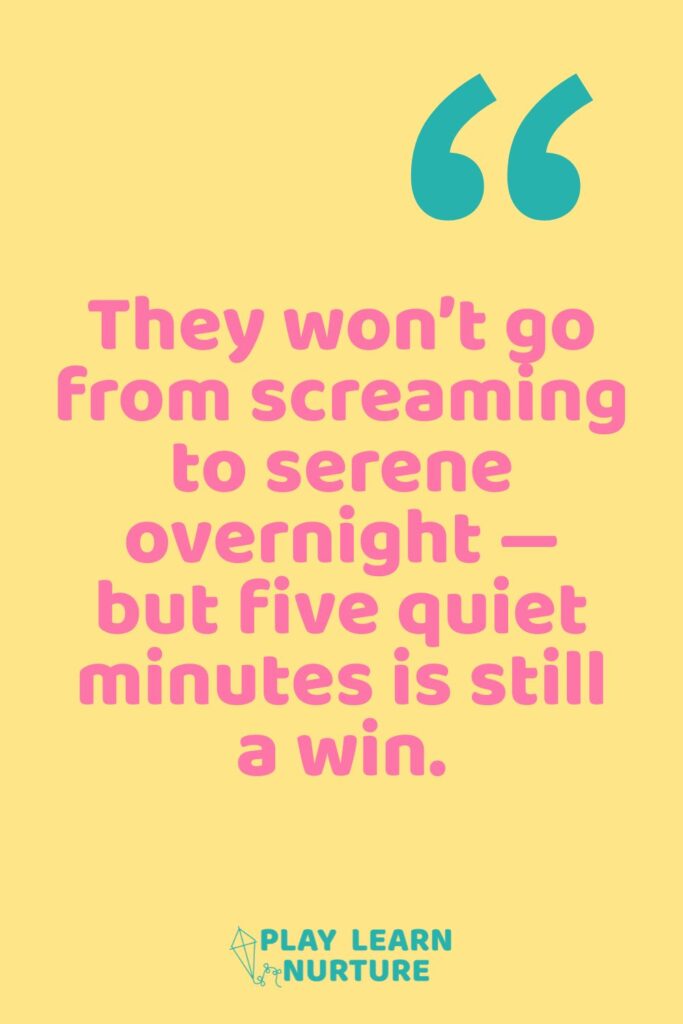
Even with the best setup, the right toys, and your Pinterest-worthy expectations, sibling independent play is still going to fall apart sometimes. Because kids are kids. They’re learning how to share space, manage emotions, and not launch toys at each other when things get heated.
Here’s how to reset when it all turns to chaos:
Sometimes the problem isn’t the kids — it’s the environment. If there are too many toys, not enough space, or constant distractions, sibling independent play becomes harder to sustain.
Try:
Reducing toy choices
Swapping in familiar favorites
Adding a calming sensory element (like a bin of rice or kinetic sand)
Designating two play zones, even just on different ends of the same mat
If one particular toy always ends in a screaming match? Put it away for a bit. Rotate it back in later when their co-play skills are stronger. Not every toy supports sibling independent play equally — and that’s okay.
Sometimes kids need connection with you before they can play without you (or each other). Try 10 minutes of engaged “together time,” followed by encouragement to go play on their own or side-by-side.
Sibling independent play often works better after their “attention cup” is filled first.
If things are escalating, it’s okay to press pause. A quiet book on the couch, a solo snack, or just a few minutes in different rooms can reset the tone. Not every play session needs to be a win — it’s the long game that counts.
Keep a go-to fallback ready for days when sibling independent play isn’t happening.
Ideas include:
Rice bin with two scoops and bowls
Giant sheet of butcher’s paper with crayons
Sticker books with a “no grabbing” rule
Bath play (yes, even mid-day)
These can diffuse tension and give you time to regroup.
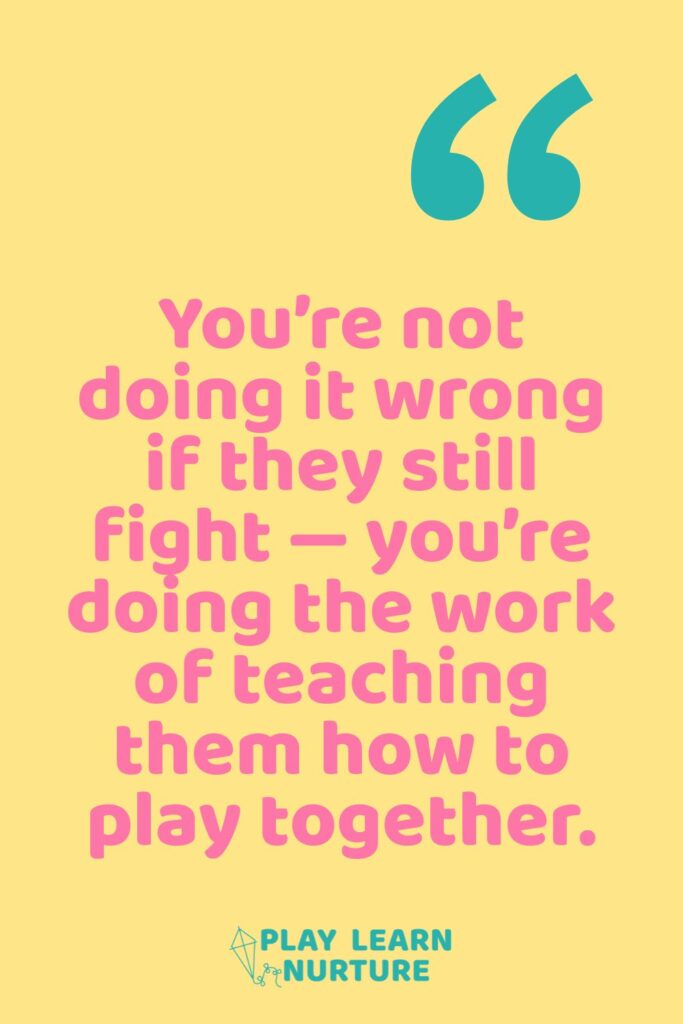
It’s easy to feel like a failure when sibling independent play turns into chaos. You hear yelling, toy grabbing, tattling, and wonder, “Shouldn’t they just know how to play together by now?”
But here’s the thing — they don’t. Not yet.
Sibling independent play is learned. It’s built slowly, through tiny moments of cooperation, not perfection. Through quiet wins you almost miss: a shared giggle, a block tower built together, five peaceful minutes while you drank your coffee hot.
Those moments? They matter.
So if it still feels like you’re more referee than parent, know this: you’re not raising rivals. You’re guiding a relationship. You’re giving your kids the chance to learn the hard stuff — like patience, problem-solving, and playing alongside someone with their own ideas.
And every time you create space for sibling independent play, even when it backfires, you’re moving closer to calm.
Less chaos. More cooperation. That’s the goal — and you’re getting there.
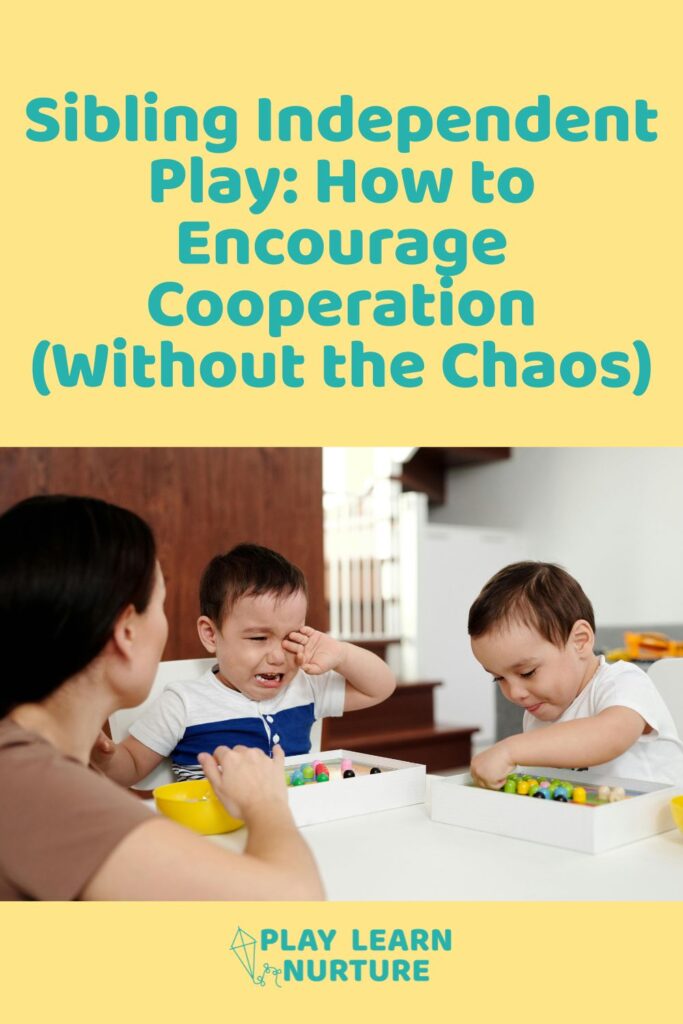

From magnetic tiles to dolls and pretend kitchens, these 15 toddler toys are actually worth the shelf space — and designed to encourage solo play
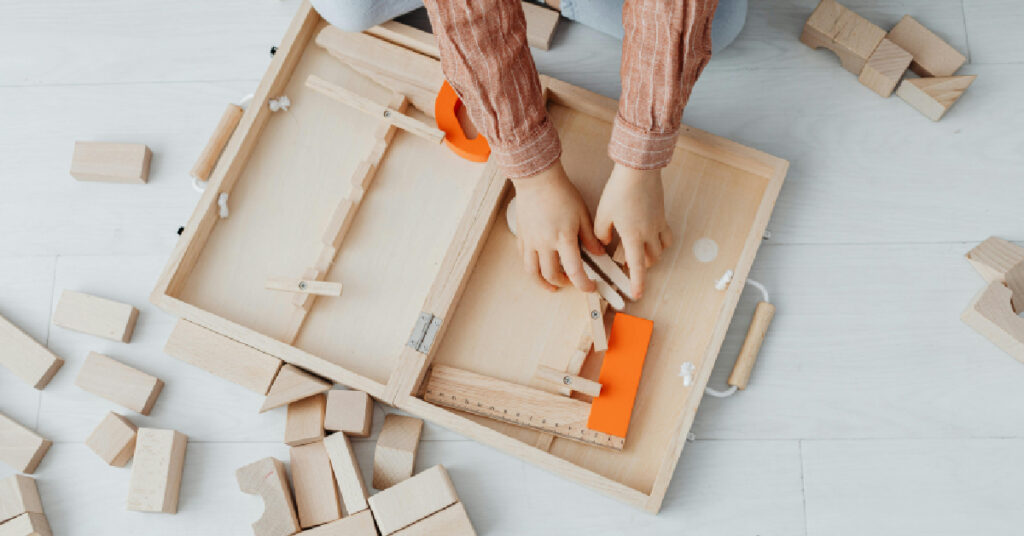
Delve into the world of loose parts play with our selection of toys that inspire exploration and innovation. Perfect for enhancing your toddler’s sensory and
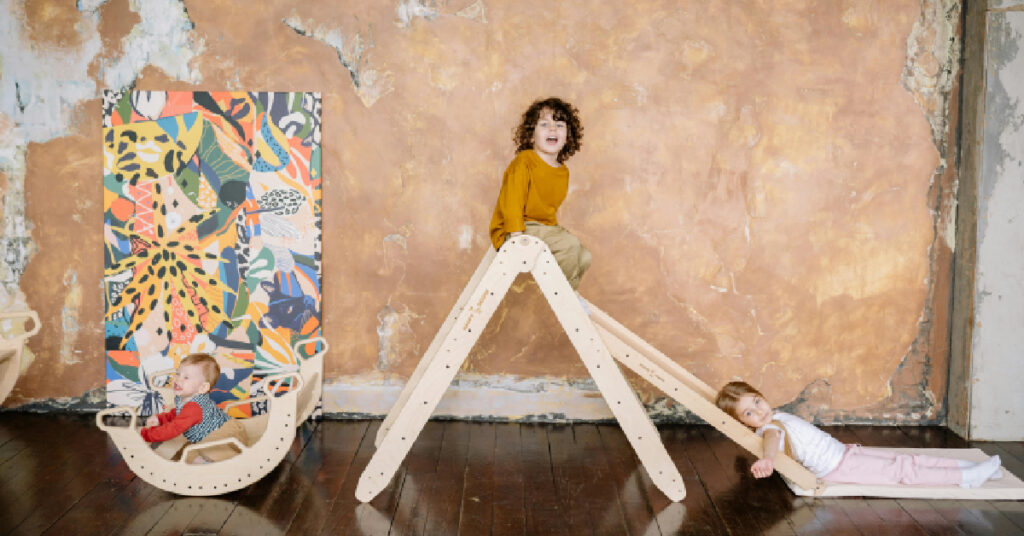
Simple, real-life play space ideas for toddlers that spark imagination, support independence, and give you a moment to breathe — no Pinterest-perfect setup required.

When the milk spills, the toddler tantrums, and your patience snaps before 9AM — you’re not failing. This is one mum’s story of surviving the
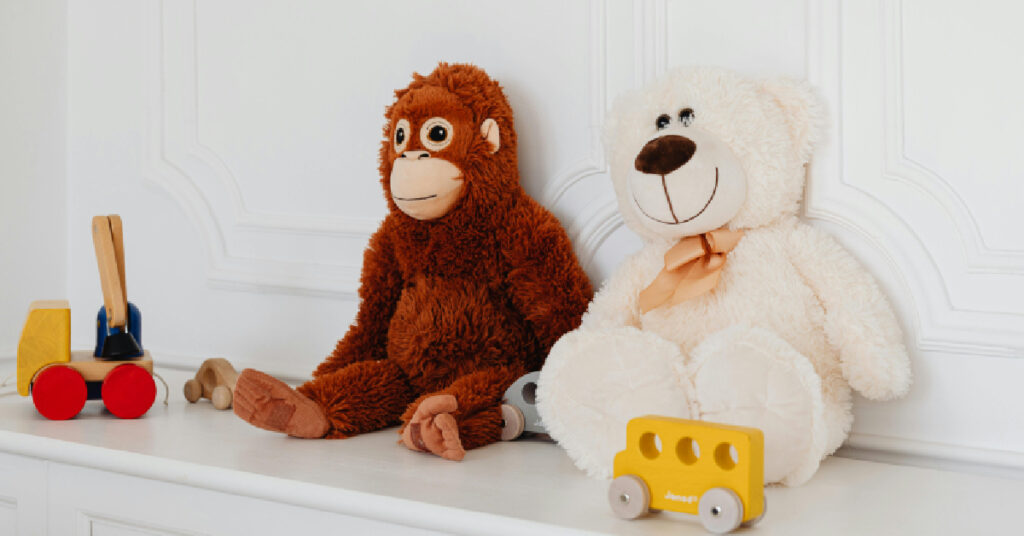
Discover how a simple toddler play schedule can create calmer days, boost independent play, and give you back precious breathing space — no strict routines

One chaotic morning, I realised the tension in the house wasn’t just coming from my toddler — it was coming from me. This is the